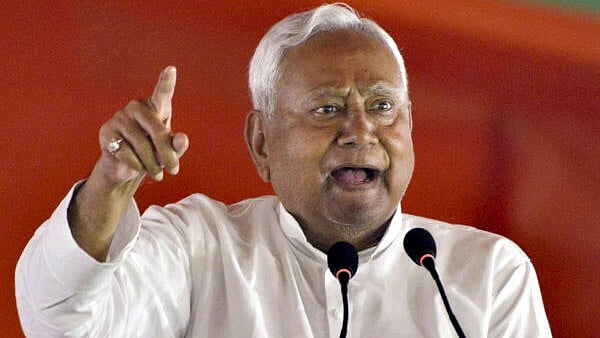
Bihar Chief Minister Nitish Kumar
Credit: PTI Photo
The National Democratic Alliance (NDA)’s decisive victory in the 2025 Bihar Assembly elections, securing an overwhelming 202 seats out of 243, is an undeniable testament to the political longevity of Chief Minister Nitish Kumar. For a leader sworn in for an unprecedented 10th time and now the longest-serving chief minister in the state’s history, the mandate signals an absolute consolidation of the ‘Sushasan Babu’ brand.
However, a deeper analysis reveals a fascinating paradox: the only benchmark Nitish Kumar failed to surpass was the one he established a decade and a half ago. In 2010, the erstwhile National Democratic Alliance (NDA) coalition swept the state with a historic 206 seats. In a landscape where rivals consistently failed to build a powerful counter-narrative, it is Nitish Kumar's own electoral record, the 206 figure, that emerges as his most formidable competitor.
Social engineering through delivery
The core of the support for the ‘Sushasan Babu’ brand lies in social engineering through governance, focusing on women and the marginalised communities. By implementing 50% reservation for women in Panchayati Raj institutions, and a 35% quota in government jobs, he unlocked a formidable female vote-bank. This was buttressed by the appointment of 7 lakh of teachers and systematic delivery of the basics: electricity, water, and infrastructure.
Nitish Kumar has been cited globally, notably by the UN, for the transformative impact of schemes such as the Mukhyamantri Balika Cycle Yojana, which dramatically boosted female school enrolment and became an international case study in social development. Furthermore, his government’s classification of the Mahadalit and Extremely Backward Classes (EBCs) into distinct, targeted groups ensured development benefits reached the most destitute, carving out a loyal political base.
Alchemy of governance and coalition politics
Crucially, the election was a competition between two fundamentally different approaches to coalition politics. The victorious NDA proved its efficacy as its constituents — including the BJP (89 seats), JD(U) (85 seats), and LJP(RV) (19 seats) — complemented each other’s social bases, consolidating votes across the board.
The Opposition, however, struggled within the Mahagathbandhan (MGB) framework. In the 2020 Assembly polls, the Congress contested 70 seats, but its strike rate was dismal, securing only 19 seats and contributing just 9.48% of the total vote share, even as its senior ally, the RJD, emerged as the single-largest party with 75 seats.
This pattern persisted in the recent election, where the Congress was limited to contesting 61 seats. While the RJD remained the anchor, its major ally, the Congress, failed to pull its weight. With its poor strike rate and inability to transfer votes, the Congress effectively became an electoral liability. Consequently, the MGB's fight became a localised RJD election, unable to match the comprehensive NDA machinery.
Compulsion of caste and the message to Lalu Prasad
Nitish Kumar’s political longevity is also an astute lesson in transcending caste arithmetic. He belongs to the numerically small Kurmi community (2.87%). This factor led him to seek broader alliances and deliver for groups beyond his own, allowing him to project himself as a leader above narrow caste politics. This contrasts sharply with the earlier-era politics of leaders like Lalu Prasad, whose focus on consolidating a single-caste base (Yadavs) failed to counter the growing aspirations of other voters. Nitish Kumar’s strategy was to unite the non-Yadav OBCs, EBCs, and Mahadalits, alongside the upper-caste support brought by the BJP. His victory is not a choice of identity; it is a compulsion driven by the electorate’s demand for immediate, effective work.
Unfinished business
The roots of the NDA’s dominance must be understood through the lens of a state defined by demographic pressure and historical neglect. According to the NITI Aayog (2025), with a projected population density of 1,307 persons per sq. km, Bihar remains one of India's most densely populated states. In this impoverished environment, the politics of hope and tangible delivery — making the state’s development history a comparison only with its own past — have cemented Nitish Kumar's position since 2005.
The sentiment on the ground, even in the hour of triumph, acknowledges the leader's indelible mark. This goodwill and support, however, come with monumental challenges for the new government. As a chronically poor state with a massive rural population, the priorities must remain focused. The key challenges are: reversing the persistent migrant labour drain, diversifying the economy beyond agriculture and strengthening market linkages, drastically improving the quality of education, and strengthening the healthcare sector. Most critically, the government must ensure justice and effective governance at the local level and ensure the hard-won participation of women and the marginalised translates into true economic and social justice. If the NDA can address these core governance issues in the next five years, Bihar will truly find a new, brighter light on the map of India.
Sanjay Kumar is founder, Deshkal Society, and co-editor, Interrogating Developments: Insights from the Margins. Shruti is a doctoral scholar and independent researcher.
Disclaimer: The views expressed above are the author's own. They do not necessarily reflect the views of DH.